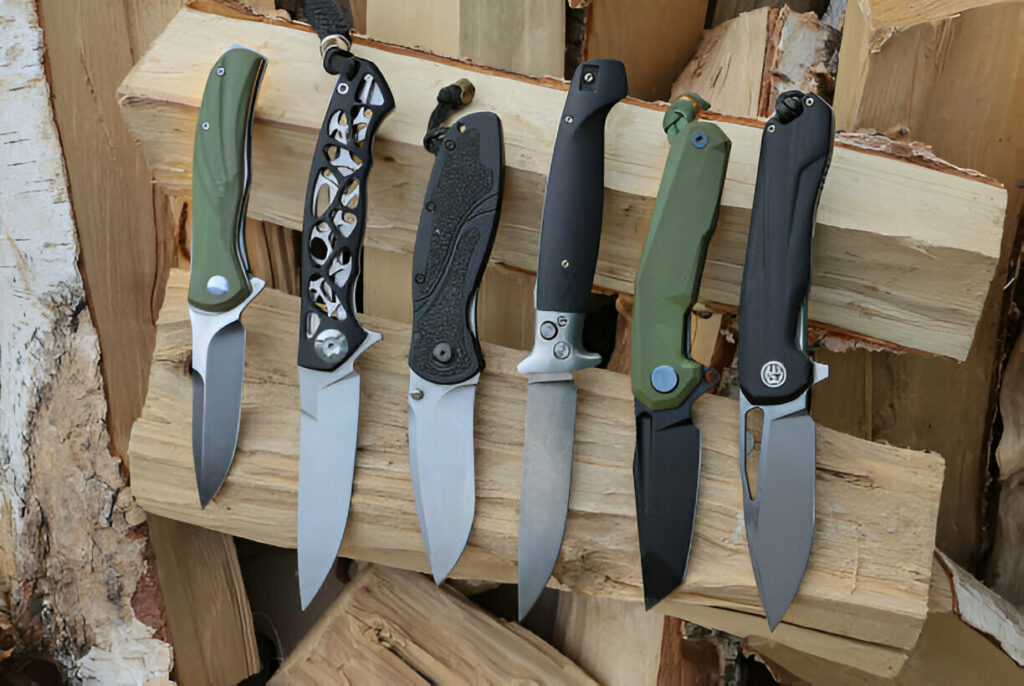
It’s always surprising how few people carry a pocket knife until the moment one is needed. I’ve witnessed countless helplessly searching faces at a mountaintop picnic when a salami needs to be sliced or when someone struggles with a stubborn zip tie that needs to be cut. A quality pocket knife is the most versatile useful tool you’ll use throughout your day – from opening an Amazon package to removing tags from products, cutting a lime wedge for your beverage during a boat day, or handling unexpected challenges during outdoor activities like camping, hiking, and fishing. When household tools are out of reach, the ability to deploy your blade and solve these problems makes a pocket knife truly invaluable.
The basic design of a folding pocket knife hasn’t changed much over the centuries, but the options have certainly evolved. Today’s market offers diverse styles and mechanisms that make knives both enjoyable to use and collect. While any knife can perform the core function of cutting, carrying one daily will develop your preferences for look, feel, and function. Important factors in determining the right pocket knife include types of blade steel, opening mechanisms, locking mechanisms, various sizes and weights, and whether you want a basic single-blade folding knife or multi-tool versions with scissors, corkscrews, and other features. With prices ranging from cheap folders costing a few dollars to custom blades going for over $1,000, there’s a choice for everyone. As someone who personally used and test dozens every year, I’ve found options across a range of styles and price points that showcase the perfect balance of quality blades, ergonomic handles, and portability to handle all your jobs efficiently.
The Best Pocket Knives
- Best Overall Pocket Knife : Kershaw Iridium Folding Pocket Knife
- High Performance Heritage Design : Benchmade – North Fork with Stablized Wood Handles
- Best Value : Gerber Gear LST Gifts for Men
- Best Everday Carry : Kershaw Leek Stainless Steel
- Best Spring-Assisted : CRKT Bamboozled with Liner Lock
What to Consider in a Pocket Knife
Metal Makes a Difference
When selecting among the best pocket knives, understanding blade steel becomes crucial—though this is where knife geeks often get lost in the weeds. There are inevitable tradeoffs with each type of steel: I’ve found that softer steel in a blade may become dull more quickly but remains easier to sharpen even for beginners, while harder types of steel hold an edge longer but prove trickier for novices trying to sharpen at home. After testing dozens of knives over the years, I’ve learned that steel characteristics significantly affect how prone a knife is to rusting—thankfully, most decent modern pocket knives use rust-resistant metals that don’t require much special care beyond occasional wiping and proper storage. My personal preference leans toward mid-range hardness that balances edge retention with maintenance simplicity.
When choosing a pocket knife, the steel used in the blade truly shapes your experience. CPM Magnacut offers great all-around performance, while CPM S90V is a higher-end, rust-resistant steel that holds an edge exceptionally well but can be brittle and tougher to sharpen at home. Many knives use D2, a common option for lower-cost pocket knives that’s easy to sharpen. 440A/C represent lower-cost stainless steels that resist rust and are easy to sharpen but aren’t as durable as premium options (440C is slightly better than 440A). Beyond the blade, your handle material is an important choice too – while I prefer the natural feel and look of wood, it’s less common and less durable than lighter, more durable synthetic materials like G10 or carbon fiber. I’ve carried a Crucible steel blade for years, and the difference in edge retention compared to budget steels is remarkable.
Find the Right Fit in Your Hand
The dimensions of a pocket knife profoundly impact how it fits in your hand, affecting your ease of use and overall satisfaction. Bigger hands typically struggle with tiny knives (and vice versa), but how you plan to carry and use the tool shapes your preferences too. As someone who’s worked both in an office setting and on a family farm, I’ve learned that an executive might prefer something less obvious for daily carry, while those in the trades benefit from a burlier blade that handles prying tasks and day-to-day abuse. Most pocket knives feature a blade length between 2.5 to 4 inches, with 3 inches being quite manageable for most users, though legal restrictions in certain areas may limit your choice (worth checking before purchase).
Beyond just blade size, consider the overall length when opened (typically double the blade length since handles are usually longer) and the closed length measurement (the standard way to ensure it will fit comfortably in your pocket when clipped). Weight is also a big deal – most modern EDC knives range from 1.5 to 3.5 ounces, a seemingly tight range where even half an ounce makes a noticeable difference in heft. Knives exceeding 4 ounces tend to be all-steel and often oversized. Personally, I prefer a slightly heavier all-metal folder, though some appreciate featherlight options. Don’t overlook thickness either – a slim knife with flat scales and a lower thickness measurement (under a half-inch) will be less noticeable to you and others when carried.
Easy Opening and Closing Counts
The opening action of a pocket knife plays an outsized role in your daily appreciation for the tool. After testing dozens of folding knives over the years, I’ve noticed the ones I reach for most are those that are subjectively satisfying and let me operate one-handed when my off hand is busy. How quickly you become proficient with a mechanism depends on its design, with each style having unique strengths and weaknesses to consider. The classic thumb stud – mounted on the blade – lets you push open and pull closed with your thumb. While they don’t require much finesse to hit and open reliably, not everyone enjoys their feel. A nail nick or thumb hole (a slit or hole in the blade) works similarly, letting you push with your thumb or thumbnail for smooth operation with practice. I’ve found nail nicks particularly behave differently depending on the length of your thumbnail and aren’t ideal if you keep your nails very short.
My personal favorite is the flipper – a tab on the spine that you pull with your forefinger to quickly spin the blade into locked position. A smooth flipper is incredibly satisfying once you’re proficient, offering relative speed and reliable complete opening to locked position. The CRKT Bamboozled is a great example of this design done right. For even quicker deployment, assisted openers use an internal spring with a flipper or other opening mechanism for faster, automatic-like opening. True automatic knives let you press a button that deploys the knife without manually actuating yourself – including out-the-front blades like the Microtech models featured in many collections. Just remember these may be restricted in certain places, so check local laws before carrying one.
Look for a Secure Locking Mechanism
While secure locking mechanisms weren’t common in the previous century, today they’re expected if not universal in quality pocket knives. Classic knives like Case’s beloved Stockman and Victorinox’s iconic Swiss Army Knife use slip joints that hold blade open but don’t truly lock – I learned this lesson the hard way when a folding knife closed on my finger years ago. For increased safety, I strongly recommend choosing a pocket knife with some kind of locking mechanism, though if you’re comfortable with a slip joint or other non-locking blade and enjoy the style, by all means, buy one. Remember that your choice of lock dictates how you close the knife, creating a major impact on how easy it is to operate daily.
Popular options include frame locks and liner locks, mechanisms grouped together because they operate similarly while using different parts of the handle to accomplish the same thing – one side of the liner or lock is bent inward and slips behind the blade when open to lock in place. Closing requires pushing the liner or frame out, usually done one-handed. The lockback uses the spine of the handle that locks into the back of blade for a very secure lock, though the downside is simultaneously releasing the back lock and closing blade requires two hands. I personally prefer the crossbar lock (with Benchmade’s AXIS lock being the best-known example) which slides into a notch in the blade to securely lock out the knife. Lots of brands offer bar locks, though cheaper knock-offs are not as tight or secure. This type of lock is fairly easy to close one-handed and most work the same for right-handers and left-handers. The button lock (name says it all) lets you free the blade by pressing a button, with the biggest benefit being you can usually close the knife one-handed without ever putting fingers in the closing path of the blade – though lefties need a left-hand specific model when available.
Pay for the Appropriate Purpose
Your budget will be a major factor that will quickly narrow your range of options when shopping for pocket knives. While prices range from a few dollars to hundreds or even thousands for custom, limited-edition pieces from celebrated knifemakers, most people end up looking at what we call “production knives” – models that are mass-produced in a factory rather than handcrafted by individual knifemakers. These blades typically run up to $500 or so, though the price range is much tighter because the cost to produce is lower. After years of collecting, I’ve found that matching your budget to your actual needs saves both frustration and money.
Knives less than $20 usually feature softer, cheaper steels and inexpensive handles with less quality control than pricier models, but you can still find a decent knife from an established manufacturer for less than $50 any day. The cheapest knife I recommend costs about $25 and has served me well for basic tasks. When choosing a pocket knife with harder carbon steel, expect the price to push closer to $100 or more. Once you go past the $100 price point, you’re mainly paying for specific designs, brand names, and other personal preferences – you’ll start seeing diminishing returns in terms of raw functionality. I spent $200 on a premium folder that cuts only marginally better than my $75 workhorse, but I appreciate its unique design and smoother action.
Don’t Break the Law
In the United States, legally carrying pocket knives requires understanding various state laws and rules that may restrict what you can carry. Each state has different prohibitions regarding automatic knives, blade length, and whether knives can be carried concealed. During my years collecting tactical folders, I’ve found the American Knife and Tool Institute’s comprehensive state by state guide to knife laws invaluable when traveling across state lines. When traveling abroad, be aware that regulations differ widely among countries – Austria has minimal restrictions, while Norway, despite its rich knifemaking heritage, enforces a strict ban on carrying knives in urban areas. Always research local laws before packing your favorite blade for a trip.
How We Evaluated and Tested Pocket Knives
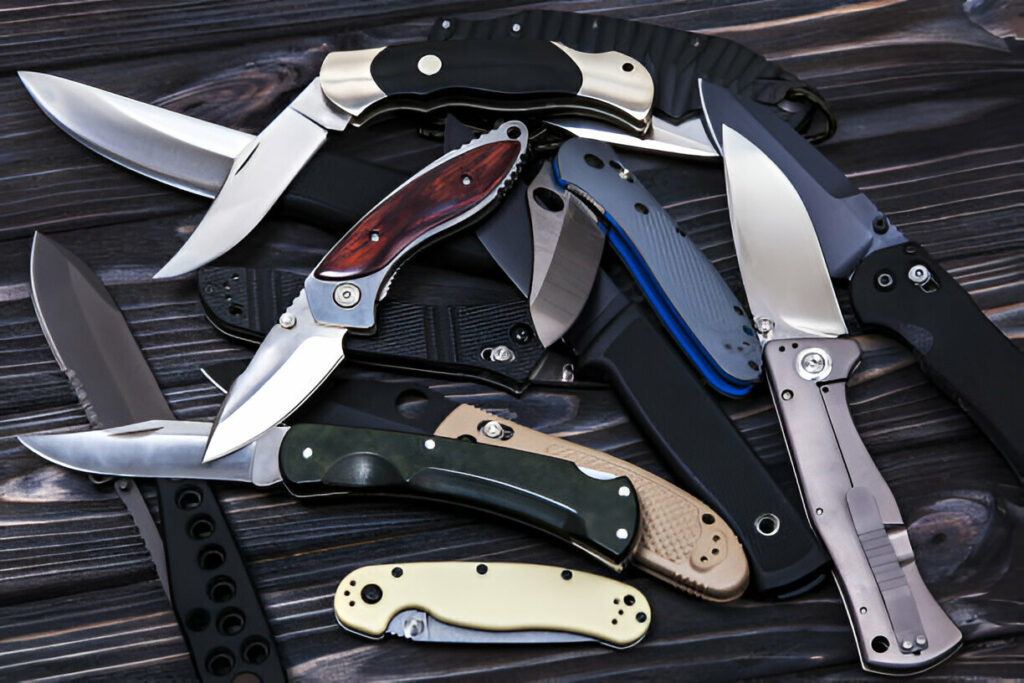
After years of carrying knives daily (nearly 25 years to be exact) and reviewing them for over 10, I’ve developed a rigorous testing protocol to identify the greatest pocket knives for this guide. I narrowed the scope to include only widely available models from major manufacturers in North America that won’t break the bank—nothing too expensive but plenty of options to match different preferences, budget, and lifestyle. My recommendations come from testing the latest releases from big knife brands each year, subjecting them to real daily tasks from opening packages to field dressing elk when I’m lucky.
For each knife, I establish a baseline by checking the factory edge for sharpness, testing corrosion resistance with a salt water bath and air drying, and often disassembling to examine the lock and open/close mechanisms. After beating each knife through regular use, I sharpen the blade using stones with an angle guide to evaluate how easily they return to sharp. One of my favorite tests involves handing knives to friends, strangers, and other regular people to see how they react when opening and closing a knife for the first time—their unfiltered responses tell me volumes about real-world usability that you won’t find in spec sheets from big name brands.
Our Full Pocket Knife Reviews
1. Best Overall Pocket Knife
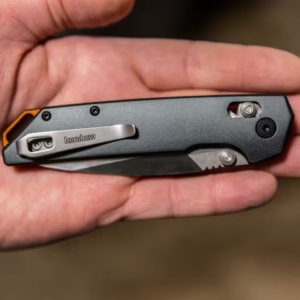
Kershaw Iridium Folding Pocket Knife, 3.4 inch D2 Steel Blade, DuraLock Locking Mechanism, Pocketclip
Now 17% Off
PROS
Secure bar lock-out system that rivals more expensive brands.
Excellent grip and ergonomics for everyday carry and use.
Multiple versions available to fit different budgets.
CONS
Can be slick in wet or muddy conditions, creating potential handling issues.
D2 steel requires more maintenance than premium steels to prevent rust.
The Kershaw Iridium stands out among recent releases as an exceptionally popular option that hits the sweet spot of size, weight, and style. At just over 3 ounces with a 6061-T6 aluminum handle and slim profile, this knife remains barely noticeable in your pocket while the 4.5-inch length fits perfectly in medium-sized hands. I’ve carried mine for months now, and the one-handed easy open and closure mechanism has become second nature. While not ultralight, it looks cool and features a secure Benchmade-style crossbar lock that inspires confidence during heavy use. The modern design features make this knife both functional and visually appealing.
Kershaw specializes in low- and mid-priced production knives with high quality control, creating designs that simply work. Unlike some budget brands that flood the market, they release fewer knife designs but offer multiple variations of their popular models using different materials across a variety of price points. The core of the Iridium series delivers exceptional value with most versions priced modestly at less than $100, though the titanium handle edition approaches Benchmade prices. The original features D2 steel, offering decent edge retention and durability common in lower-cost knives, though it can rust with abuse. For those concerned, the black oxide-coated D2 blade provides a compromise option that keeps all but the cutting edge sealed off from moisture.
Key Specs
Weight 3.3 oz
Blade Length 3.45 in.
Closed Length 4.5 in.
Blade Steel D2
Locking Mechanism Dura Lock (crossbar lock)
2. High Performance Heritage Design
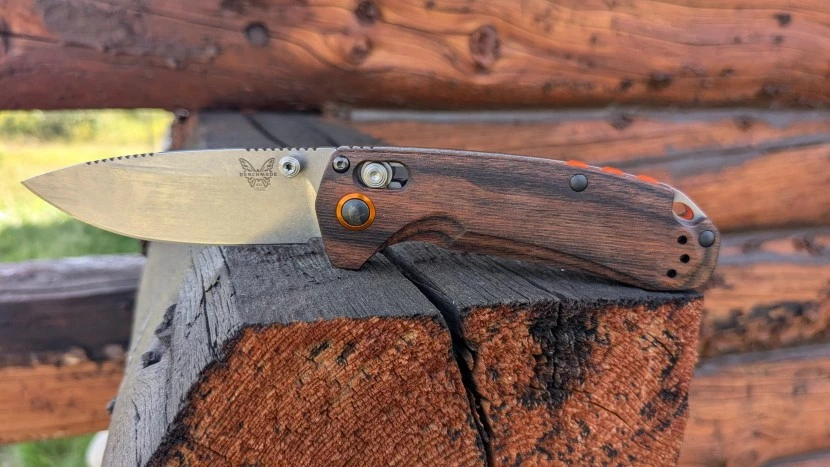
PROS
Premium CPM S30V alloy offering superior edge retention and corrosion resistance.
Benchmade’s famous Axis blade lock system provides exceptional security and one-handed operation.
Ergonomic design with pronounced ridges for enhanced control during tough cutting tasks.
CONS
Heavier than specialized hunting options like the Havalon Piranta (3.25 vs 1.85 ounces).
Current updated version has lost the recurve-bladed design beneficial for dressing a kill.
The Benchmade 15032 North Fork is an exceptionally well made folder that combines a traditional look with modern performance that rivals the Mini Barrage in quality. Despite being marketed as a hunting knife, its reasonable weight of 3.25 ounces and closed length of 3.91 inches make it incredibly portable. As our lead tester Kyle Hameister noted during field testing, it will practically “disappear” in your pocket while remaining ready for action. The impressive all-around blade made from top-of-the-line CPM S30V alloy is what sets this knife apart—this upgraded steel scores high marks for being characteristically balanced with excellent edge retention, superior corrosion resistance, and remains easily sharpened when needed. The subtle orange accents in the handle add a nice design touch, while the pronounced ridges along the spine of the blade create perfect anchor positions for your thumb pad when applying added pressure during tough cutting tasks.
This beautiful high-end knife features Benchmade’s famous Axis blade lock in a non-assisted version, which enhances cleaning after messy tasks like field dressing. Though somewhat shoehorned under the hunting knife label, the North Fork’s longer blade measuring 2.85 inches serves multiple purposes beyond hunting. For dedicated hunters, I might recommend the Havalon Piranta with its field-swappable 2.31-inch scalpel blade as a specialized hunter’s companion that eliminates concerns about sharpening in the wilderness. While the Piranta is smaller and less comfortable in hand, it’s easier to clean and weighs a significant 43% less (1.85 ounces versus the North Fork’s 3.25)—on long trips, every ounce counts. Worth noting is the CRKT Drifter, one of the few popular recurve-bladed knives excellent for dressing a kill, a feature present in the first generation North Fork but lost in the current updated version.
Key Specs
Weight 3.25 oz
Blade Length 2.9 in
Closed Length 3.9 in
Blade Steel D2
Locking Mechanism AXIS Lock
Handle Stabilized Wood
Clip Mini Split-Arrow
3. Best Value
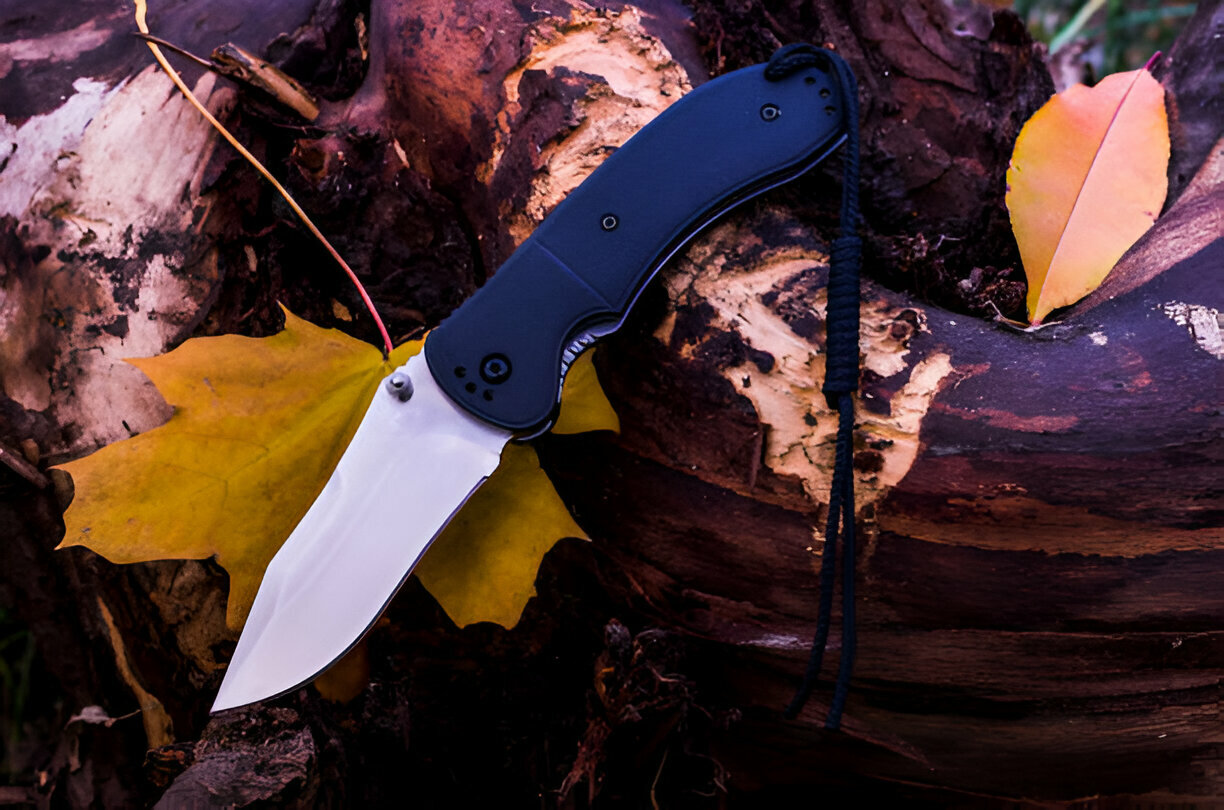
Gerber Gear LST Ultralight Pocket Knife, EDC Stainless Steel Folding Knife with Fine Edge for Survival, Gifts for Men
PROS
Ultralight design with robust build for its size and weight.
Detachable pocket clip for versatile carry in pack or purse.
Historic EDC design updated for modern use while staying under $25.
CONS
Softer steel requires more frequent sharpening than premium knives.
Too small for users with larger hands who need more substantial tools.
Gerber’s LST (Light, Strong, Tough) is often credited with spawning the modern Everyday Carry (EDC) pocket knife phenomenon back in 1981. This lightweight, affordable folder has sold millions and inspired numerous imitators (including Walmart’s Ozark Trail $4 folder, essentially an LST clone). While the basic model maintained consistent construction and materials since the 1980s, 2025 brought exciting changes with a lightly updated LST, an LST Mini, and an LST Ultra featuring a black oxide-coated blade. After carrying various LST versions for years, I’ve found their ultralight nature and robust build relative to size and weight make them ideal companions for daily tasks.
True to its roots, the LST remains under $25 while staying faithful to its name. The switch from 420HC steel to 440A isn’t a radical switch – both are easily sharpened though somewhat less-durable budget stainless steels. While the overall dimensions remain similar, the transformation in aesthetic and shape is notable. The redesigned handle scales feature a more modern profile for a secure grip, while the drop-point blade sports a gradually tapered belly and nail notch for easier opening. The detachable pocket clip adds versatility, allowing for slipping the knife into a pack or purse without snagging. Notably, you can now choose from six solid-color options beyond the original black. I’ve found this knife particularly useful for light daily tasks where an unobtrusive carry is essential.
Key Specs
Weight 1.3 oz
Blade Length 2.5 in
Closed Length 3.7 in
Blade Steel 440A
Locking Mechanism Lockback
4. Best Everday Carry

Kershaw Leek Pocket Knife, 3″ 14C28N Stainless Steel Drop Point Blade, Spring Assisted Knife
PROS
Constructed like a work of art with premium Sandvik 14C28N stainless steel alloy blade.
Adaptable assisted opening system with both blade studs and well-tuned flipper tab.
Very portable design makes it an ideal everyday companion.
CONS
Thin handle doesn’t allow for applications requiring high torque.
Fragile blade with a tip that can deform slightly under pressure.
The Kershaw Leek stands out as a knife constructed like a work of art with its sleek, beautiful design and pedigreed blade. At just 3-ounce when open to its full 7-inch length, this compact assisted-opening knife delivers premium performance at half the price of comparable high-end options. The Sandvik 14C28N stainless steel alloy blade arrives sharp and defect-free from the factory, ready for immediate use. I’ve found its adaptable assisted opening mechanism truly impressive—it can be opened using either thumb via the blade studs or with the well-tuned flipper tab along the spine, making it quick to open in virtually any situation. This impressively well built knife positions itself as a strong competitor to the more expensive Benchmade 535 Bugout and Benchmade Mini Barrage 585, while remaining reasonably priced and super portable for an everyday companion.
While the thin profile makes the Leek ideal for carrying, some users have disliked the handle design due to certain compromises in overall utility. In my experience, it’s excellent for light cutting tasks where precision matters, but as lead tester Kyle Hameister notes, you “wouldn’t trust” it for heavier-duty work—the thin handle doesn’t allow for high torque application, and the somewhat fragile blade is not meant for heavy slicing or prying. During our testing, we even observed the tip deform slightly under pressure. For those needing something with a similar shape and profile but slightly thicker, the CIVIVI Elementum II can better stand up to medium-duty tasks and sells for even less than the Leek. Alternatively, the Kershaw Link offers a truly heavy-duty option for bigger jobs where robustness is essential.
Key Specs
Weight 3 oz
Blade Length 3 in
Closed Length 4 in
Blade Steel 410A
Locking Mechanism Tip-lock
5. Best Spring Assisted
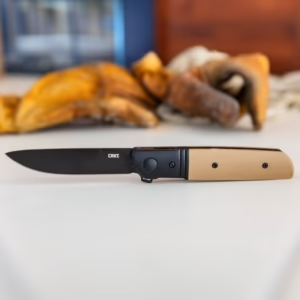
CRKT Bamboozled Everyday Carry EDC Assisted Folding Knife with Liner Lock: D2 Steel Plain Edge Blade, G10 Handle with Stainless Steel Bolster
PROS
Smooth, fast, fun opening action that’s reliably one-hand operable.
Black oxide blade finish providing improved rust-resistance for the D2 steel.
Excellent value at under $70 while maintaining the quality of the Onion family’s signature designs.
CONS
Thicker body that sits substantial in the pocket and doesn’t hide well during pocket carry.
Not as lightweight as many competing EDC options in the same price range.
The Bamboozled represents the continuing legacy of the Onion family in knife design, with Kenny Onion having followed in the footsteps of his father, Ken Onion—one of the best-known modern knifemakers whose collaborations with Kershaw Knives (like the Leek) earned him tremendous popularity. After the elder Onion partnered with Columbia River Knife and Tool (CRKT), his son brought his own signature designs under the CRKT banner. I’ve found the Bamboozled maintains the father’s iconic but affordable designs philosophy, as it retails for under $70 while delivering premium functionality. The knife utilizes the smooth, fast Speedsafe assisted opening action the father created, delivering a satisfyingly fun opening action that’s consistently reliable and one-hand operable even after months of regular use.
Unlike ultralight options, the Bamboozled isn’t small or ultralight—it sits rather thick in the pocket, which means it doesn’t hide well during pocket carry. However, its relatively long and slim profile positions it somewhere between your average EDC flipper and CRKT’s slender CEO model. Available in three different color combos, I particularly recommend versions with the black oxide-coated blade which adds rust-resistance to the robust D2 steel. The black oxide blade finish has held up remarkably well during my testing, showing minimal wear even after frequent use in humid conditions, making this a dependable tool for both everyday tasks and outdoor adventures.
Key Specs
Weight 4 oz
Blade Length 3.31 in
Closed Length 4.45 in
Blade Steel D2
Locking Mechanism Liner Lock
FAQs: Shares Expert Blade Buying Tips.
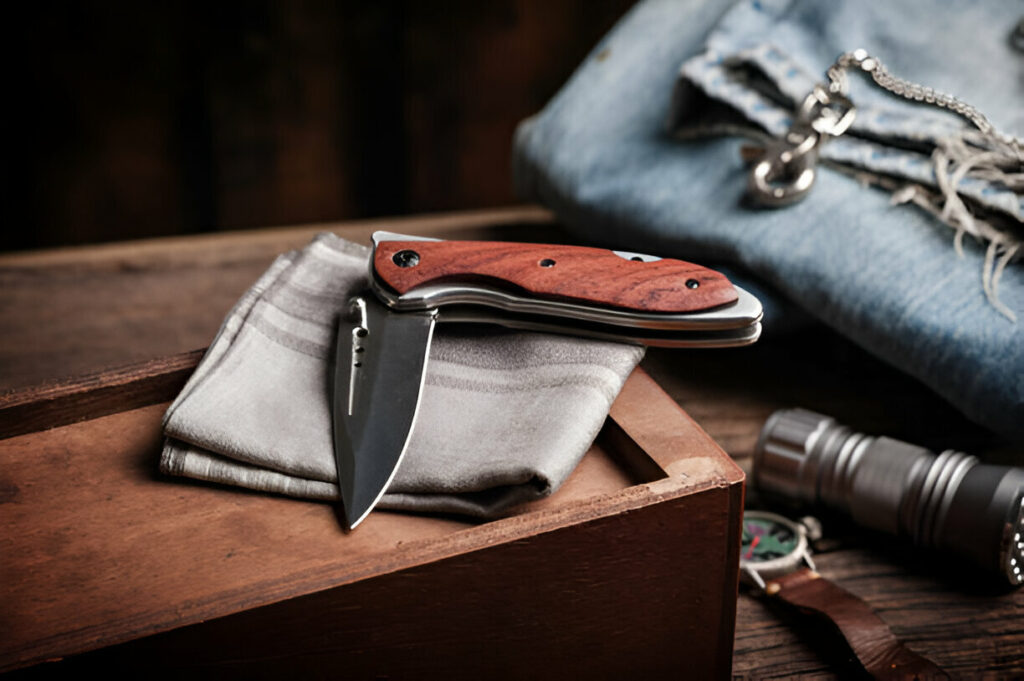
Are there legalities with shipping pocket knives and with blade length?
The legal definition of pocket knives can vary significantly between states and at the federal level, which may impact the shipment and receipt of your purchase. While living in “wild west Colorado,” I discovered it’s actually illegal to carry a blade longer than 3.5 inches concealed “in your pocket,” despite the state’s reputation for freedom. Contrast this with New York state, where switchblades are illegal and you must be a U.S. citizen to own a knife, but there are no concealed carry restrictions. Before purchasing, I strongly recommend you “Check your state laws here” to understand the specific restrictions that govern how you can carry a knife on your person in your area.
Beyond local laws, finding a knife that properly fits your hand is equally important. During my years as a regular pocket knife carrier, I’ve found that what feels tiny and awkward in my larger hands might be absolutely perfect for someone else. If you’re new to pocket knives, visit an outdoors store where you can handle a wide range of knives to discover what feels good in your grip. Most users find blades in the 2.5- to 3-inch range most comfortable for everyday tasks, though those with bigger hands might prefer something more substantial. This hands-on approach has saved me from several disappointing online purchases that looked great in photos but didn’t work well with my hand size.
How should I keep my pocket knife sharp?
A word of caution—you might not actually want a surgically sharp pocket knife for everyday use. When using my knife frequently and casually, I’ve found that an ultra-sharp blade requires being overly cautious, which defeats the purpose of a convenient tool. I once carried a replaceable blade knife and ended up with several minor but annoying slices on my fingers. That said, all knives will eventually require sharpening. Most pocket knives feature an obtuse 20-degree or higher blade angle, making them less challenging to sharpen yourself. While knife sharpening is a skill that’s not easy to master. there are various tools available to help.
For beginners, the pull-through sharpener hiding in your kitchen drawers might be sufficient—these sharpeners aren’t a perfect sharpening solution, but they’re relatively idiot-proof and good enough to perk up your blade between serious sharpenings. Personally, I’ve invested in the Work Sharp Ken Onion Edition Knife and Tool Sharpener which lets you adjust for blade angle and uses electrically driven belts for a fairly quick sharpen, though it requires some practice to use well. If you’d never bother with sharpening, consider mail-in sharpening services like The Sharp Brothers, who professionally sharpen blades for a fee. Many manufacturers offer similar services—Benchmade’s LifeSharp program provides free sharpening for any Benchmade knife, while Kershaw offers blade replacement if yours becomes broken or damaged beyond repair. For the contemplative types, traditional whetstone sharpening can be quite soothing, reminiscent of Zen and the Art of Motorcycle Maintenance.
What Should You Pay for a Quality Pocket Knife?
As a longtime knife enthusiast who has carried various blades over the years, I can tell you that price doesn’t always dictate quality. In my early days, I recommend a cheaper approach to start – I once carried an incredibly cheap pocket knife from Walmart that cost just $1 (the company eventually raised it to $2). Despite its tendency to rust at the hinge, it did the trick surprisingly well. These budget knives were great for checked luggage when traveling to a destination where you might worry about losing it or having TSA took it away (no need to cry over a $2 loss). That said, with more experience, I can’t in good conscience suggest such ultra-budget options in all circumstances. Quality options like the Opinel No. 8 are recommended for those seeking better craftsmanship while still staying under $20. For new users, definitely aim for something under $50 until you develop strong opinions about what features you prefer.